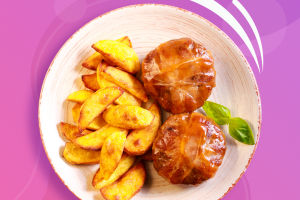Pumpkins generally ripen in late summer and early fall. In spring sowing, pumpkins are sown in March-April, bloom in May-July, and harvest in July-September. There is a pumpkin in the clip, but the skin is too thick to handle.
Here we will teach you three ways to keep it and peel it easily.
Step 1:
a. Wash the pumpkin, put it on the cutting board, hold the second half of the pumpkin with one hand, cut down with the knife with the other hand, and remove the head and stem.
b. Make a cross-cut from the middle of the pumpkin to form two parts, then turn the pumpkin cross-section down and make a lengthwise cut.
Step 2: Soften the Pumpkin Skin
a. Steam: Add a small amount of water to the pot, take a piece of pumpkin, put it in, steam the raw pumpkin for 3 minutes until the skin is cooked, then cut it.
b. Soak: Put the raw pumpkin into a large container, and soak it in boiling water for 2 minutes until the skin becomes soft, which will make it easier to cut.
c. Heating: You can also heat the raw pumpkin in the microwave for 5 minutes before cutting.
Step 3: Use a peeler
a. Hold the pumpkin with one hand and fix it, and use a peeler to peel the pumpkin with the other hand.
b. After removing the skin, use a spoon to scoop out all the pumpkin sacs
c. Then use a knife to cut into small squares or long strips;
d. Peeling the pumpkin skin with a peeler is a little bit laborious, but if the knife is not good, it is not easy to hurt your hands.
In fact, pumpkin skin is also edible. Although it is a little hard, it is very nutritious. After the pumpkin is seeded and peeled, the dietary fiber content is not high, and the pumpkin meat itself is a food with a high glycemic index.
It happens that these dietary fibers in the pumpkin skin are of vital value for delaying the rise in blood sugar. Together with the skin Eating has the effect of preventing and treating diabetes and lowering blood sugar.
In addition, pumpkin skin is rich in zinc, which participates in the synthesis of nucleic acid and protein in the human body. It is an inherent component of adrenal cortex hormones. It is an important substance for human growth and development.
It also has a diuretic effect and is very nutritious. However, it should be noted that when choosing pumpkins, you should choose fresh, smooth, and clean pumpkins with no scars and black spots. Such pumpkins are safe to cook and eat with the skin on.
Eating some pumpkin in moderation also has these benefits for the body:
1. Regulate gastrointestinal function: pectin in pumpkin can reduce the stimulation of intestinal mucosa by foreign objects and promote the healing of gastrointestinal ulcers.
At the same time, pumpkin contains a lot of plant fiber to assist digestion and promote defecation. For people with poor gastrointestinal tract and constipation, eating pumpkin in moderation is a good choice.
2. Stabilize blood sugar: Pumpkin is rich in cobalt. After cobalt can be absorbed by the human body, it can not only synthesize vitamin B12 but also promote the secretion of insulin from pancreatic islet B cells. Insulin has the effect of promoting blood sugar lowering, so eating pumpkin in moderation has the benefit of stabilizing blood sugar lowering.
3. Improve night blindness: Pumpkin is rich in carotene, which has antioxidant effects and is converted into vitamin A in the body, which can prevent night blindness.


